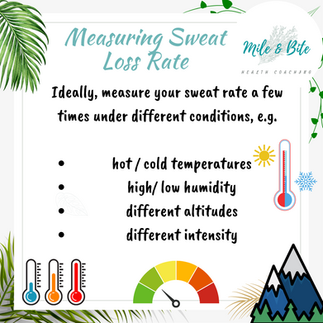Hydration for Endurance Runners - Part II. How to Measure Your Sweat Rate
- Vicky Sham

- Jun 14, 2023
- 7 min read
Updated: Jun 22, 2023
Are you an endurance runner keen to train through the summer heat and keep up with your fitness? As temperature rises, the sweltering weather can take a toll on your performance, making it crucial to stay properly hydrated.
One essential aspect of maintaining hydration during exercise is by measuring your sweat rate accurately. In this blog, we'll explore how to measure your sweat rate and share a few tips to help you stay on top of your game during the blistering hot summer.
Measuring Sweat Loss Induced by Exercise
Sweating rate (ml/ hr) = (pre-exercise BW - post-exercise BW+ fluid intake - urine volume)
exercise time in hours
To measure your sweat loss rate, follow these steps:
1. Weigh yourself before exercise without clothes, and record your weight in kilograms.
2. Exercise for a specific period (e.g., 1 hour) while keeping track of your fluid intake.
3. Weigh yourself again without clothes, sweat dried off with a towel, immediately after exercise, and record your weight.
4. Subtract your post-exercise weight from your pre-exercise weight to determine your fluid loss in kilograms.
If your pre-exercise weight is 61kg and your post-exercise weight is 60kg,
you body weight loss induced by the exercise is
61kg - 60kg = 1kg
5. Convert kilograms to ml (1 kilogram = 1000 ml) to determine your fluid loss in ml.
1kg x 1000 ml/ kg = 2000 ml
6. Subtract the volume of fluid consumed during exercise to body weight loss to determine your total fluid loss in millilitres.
If you have 500ml of fluid intake during exercise, add this to the weight loss calculated above
1000 ml + 500ml = 1500ml
7. Additionally, in case you have peed during the exercise, you will need to subtract the volume of fluid lost through urination from the total fluid loss. This volume of fluid loss can be approximated by weighing (without clothes) before and after peeing.
Let's assume 300ml of urine loss during the exercise, subtract this from the fluid loss. 1500 ml - 300 ml = 1200 ml
Sweat loss (ml) = body weight loss (ml) + fluid intake (ml)- urine loss (ml)
sweat loss (ml) = 1000 ml + 500 ml - 300 ml = 1200 ml
8. Divide the amount of fluid lost in ml by the duration of run in hours to determine your sweat loss rate in ml per hour. HINT: exercise for one hour so the amount of sweat loss (ml) measured above is also your sweat loss rate (ml per hour).
1200ml/ 1 hour = 1200 ml per hour.
Ideally you should measure your sweat rates a few times under different conditions to get a more accurate estimate of your fluid needs. For example, you should try to estimate your sweat loss rate in both hot and cold temperatures, high and low humidity, different altitudes and different intensity.
Alternatives of Measuring Sweat Rate
Another approach is to measure urine concentration before and after exercise, which is less accurate than the weighing method above but it's a convenient rough estimate of fluid loss.
A more advanced method include specialised patches or sweat collectors that you can attach to the skin during exercise, which are more precise measurements of sweat rate and electrolyte loss. But these are expensive and less practical for every day use.
Application of Individual Sweat Loss Rate
Once knowing your sweat loss rate under different conditions, you can adjust your fluid intake for different types of workouts and environmental conditions. This will not only prevent dehydration, it will help you optimise your training and performance. You can also use this new knowledge to help avoid fluid loss of over 2% of your pre-exercise body weight.
Remember, you still need to listen to your body and apply yourself in real life situations. If you feel thirsty or unwell during your run, it is also fine to drink more or less than your calculated hydration needs.
Signs of Dehydration

If you are not bothered about measuring your sweat rate, you should still look out for signs of dehydration as you train through the heat:
Thirst
Weight loss > 1% of pre-exercise body weight
Urine colour turning dark
The presence and the severity of these symptoms will reflect the extent of your dehydration. If you experience more than one of these symptoms during your run, it is essential to adjust your hydration strategy accordingly.
Hydration Strategy

Chronic dehydration is common amongst athletes, and remember for all your races:
never start a race dehydrated
drink regularly and sipping slowly
balance diet with electrolyte-rich foods
monitor urine colour
To avoid fluid loss of over 2% of your pre-exercise body weight, it's crucial to maintain electrolyte balance. Electrolytes, such as sodium, potassium, and magnesium, are lost through sweat and need to be replaced to maintain proper fluid balance. You can replace electrolytes by consuming sports drinks or electrolyte tablets during exercise.
How Much to Drink
The amount of fluid an endurance runner should drink before and during exercise or race can vary with individual's age, fitness, body weight, sweat rate, and environmental conditions. Below are some general guidelines for how to hydrate before, during and after.
Before:
2-4 hours before the race, aim to drink 5-10 ml of fluid per kilogram of body weight. For example, an athlete weighing 60 kg can aim to drink 300-600 ml to pre-hydrate.
1 hour before race, aim to consume an additional 3-5 ml of fluid per kilogram of body weight. For example, the same athlete can aim to sip an additional 180-300ml.
Aim to achieve pale yellow urine and allow time for excess fluid to be voided.
It's important to note that drinking too much fluid right before a race can cause discomfort or an urgent need to use the restroom during the race. Therefore, it's best to start hydrating early by sipping slowly and regularly in the run up to start time.
During:
The most common fluid plan is between 400-800ml per hour (roughly 100-200ml every 15 minutes). However, the precise amount can vary hugely depending on individual sweat rate and environmental conditions. You will need more for higher intensity, hot, humid, high altitudes and challenging conditions
Consider using a sports drink or hydration supplements that contains electrolytes and carbohydrates to replace fluids and nutrients lost through sweat and energy expenditure.
Remember to sip slowly and regularly to avoid stomach issues
After:
The recommended fluid intake is at least 1.25-1.5 litres per kilogram of body weight lost during exercise.
For example, if you lost 1 kilogram of body weight during exercise, aim to consume 1.25-1.5 litres of fluid to fully rehydrate after exercise. If you lost 2 kilograms of body weight during exercise, aim to consume 2.5-3 litres for full rehydration.
Drink slowly and regularly within 4-6 hours after the event.
You can use sports specific supplements (remember to read the labels and follow instructions carefully) and electrolyte rich foods to help fluid absorption.
Avoid further sweat loss, e.g. sun exposure, saunas.
Always Practice and Rehearse Your Hydration Strategy
Final reminder: aways practice your hydration and fuelling strategy during training runs to determine what works best for you. Individual fluid needs vary depending on factors such as exercise intensity and duration, sweat rate, and environmental conditions. Even if you know your sweat rate, it's always worth paying attention to your body weight before and after exercise, as well as thirst level and urine colour, to determine your own fluid needs.
In conclusion, hydration is a crucial component of endurance training. There is not a one-size-fits-all approach, and we should all adjust our strategy based on individual needs and exercise conditions. By measuring your sweat loss rate, monitoring your hydration status, and developing a hydration strategy that meets your individual needs, you can stay hydrated and perform at your best during prolonged exercise.
Health Coaching
If you want to know more about healthy eating and healthy running, get in touch for a consultation. I can help you incorporate one little healthy habit at a time and stay healthy as you build up your speed and mileage. You may also sign up to a FREE self-guided health coaching guide here!

Giveaway: Summer Bliss Recipe
This Raspberry Summer Bliss Cake is the perfect summer treat packed with colourful antioxidants - healthy, delicious, easy-to-make and vegan.
Click for free recipe.
#mileandbite #healthcoaching #hydrationtips #workouthdyration #electrolytes #stayhydrated #sportsdrinks #endurancetraining #runnershydration #drinkmorewater #trailrunnershydration #marathonhydration #fitnessblog #healthblog
References.
1. Goulet E. D. (2012). Dehydration and endurance performance in competitive athletes. Nutrition reviews, 70 Suppl 2, S132–S136. https://doi.org/10.1111/j.1753-4887.2012.00530.
2. Armstrong L. E. (2021). Rehydration during Endurance Exercise: Challenges, Research, Options, Methods. Nutrients, 13(3), 887. https://doi.org/10.3390/nu13030887
3. Knechtle, B., Chlíbková, D., Papadopoulou, S., Mantzorou, M., Rosemann, T., & Nikolaidis, P. T. (2019). Exercise-Associated Hyponatremia in Endurance and Ultra-Endurance Performance-Aspects of Sex, Race Location, Ambient Temperature, Sports Discipline, and Length of Performance: A Narrative Review. Medicina (Kaunas, Lithuania), 55(9), 537. https://doi.org/10.3390/medicina55090537
4. Klingert, M., Nikolaidis, P. T., Weiss, K., Thuany, M., Chlíbková, D., & Knechtle, B. (2022). Exercise-Associated Hyponatremia in Marathon Runners. Journal of clinical medicine, 11(22), 6775. https://doi.org/10.3390/jcm11226775
5. Cheuvront, S. N., & Kenefick, R. W. (2014). Dehydration: physiology, assessment, and performance effects. Comprehensive Physiology, 4(1), 257–285. https://doi.org/10.1002/cphy.c130017
6. Baker L. B. (2017). Sweating Rate and Sweat Sodium Concentration in Athletes: A Review of Methodology and Intra/Interindividual Variability. Sports medicine (Auckland, N.Z.), 47(Suppl 1), 111–128. https://doi.org/10.1007/s40279-017-0691-5
7. Thomas DT et al. Position of the Academy of Nutrition and Dietetics, Dietitians of Canada, and the American College of Sports Medicine: Nutrition and Athletic Performance. Journal of Academy of Nutrition & Dietetics. 2016; 116: 1 – 28. doi: 10.1016/j.jand.2015.12.006
8. Tiller, N. B., Roberts, J. D., Beasley, L., Chapman, S., Pinto, J. M., Smith, L., Wiffin, M., Russell, M., Sparks, S. A., Duckworth, L., O'Hara, J., Sutton, L., Antonio, J., Willoughby, D. S., Tarpey, M. D., Smith-Ryan, A. E., Ormsbee, M. J., Astorino, T. A., Kreider, R. B., McGinnis, G. R., … Bannock, L. (2019). International Society of Sports Nutrition Position Stand: nutritional considerations for single-stage ultra-marathon training and racing. Journal of the International Society of Sports Nutrition, 16(1), 50. https://doi.org/10.1186/s12970-019-0312-9
9. American College of Sports Medicine, Sawka, M. N., Burke, L. M., Eichner, E. R., Maughan, R. J., Montain, S. J., & Stachenfeld, N. S. (2007). American College of Sports Medicine position stand. Exercise and fluid replacement. Medicine and science in sports and exercise, 39(2), 377–390. https://doi.org/10.1249/mss.0b013e31802ca597

























Comments